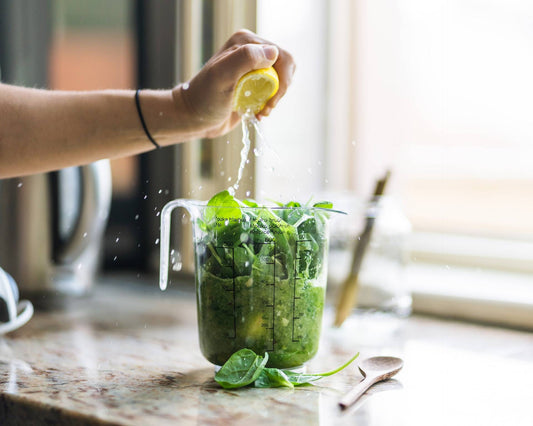

Celebrating Abundance When Choices Seem Limited
As we move into fall, the landscape around us transforms, bringing a shift in what’s available at farmers' markets and local stores. Seasonal eating in autumn—when the last harvests are gathered—invites us to savor nature’s rhythms and discover the richness of cooler months. While fall may seem to limit fresh choices, it also brings a bounty of hearty vegetables, nutrient-dense legumes, and rich, flavorful meats, all of which can sustain us through winter.
Barbara Kingsolver’s Animal, Vegetable, Miracle offers an inspiring perspective on this way of eating. Her year-long journey of consuming only what she could grow or find locally illuminates the creativity, resilience, and connection that seasonal eating fosters. She reminds us that food grown or raised nearby offers not only nutrition but a deeper relationship with our environment, our communities, and ourselves. Here, we’ll explore the bounty of fall across different U.S. regions and delve into how seasonal eating extends beyond fresh produce to include meats, dried beans, and traditional preservation methods.
The Fall Harvest Across the United States
Each region of the U.S. has a unique fall harvest shaped by its climate, offering a rich variety of flavors and ingredients. Knowing what’s in season in your area can guide meal choices, inspire new recipes, and help celebrate local traditions.
Northeast (New York)
In the Northeast, cooling temperatures bring apples, pumpkins, winter squashes, and hardy greens like kale, chard, and spinach. Root vegetables such as carrots, beets, and potatoes provide a solid foundation for autumn meals and store well for use through the winter. Apples are especially abundant, with varieties like McIntosh, Empire, and Honeycrisp at their peak—a perfect time for apple crisps, ciders, and sauces.
For protein, fall has traditionally been the season for harvesting livestock like cows and pigs, which have grazed and fattened on summer grasses. Families historically preserved meats by curing, smoking, or making jerky, methods that ensured a steady supply through winter. Today, New Yorkers can still find pasture-raised meats harvested in the fall, which pair beautifully with roasted vegetables, soups, and stews that make the most of the Northeast's seasonal abundance.
Midwest (Wisconsin)
The Midwest’s agricultural heartland bursts with fall crops: apples, root vegetables, squashes, and even late-season cranberries, a signature of Wisconsin’s landscape. Dairy also shines in this season, as aged cheeses crafted from summer’s milk reach peak flavor. Cranberries harvested from September through November add a distinctive tartness, perfect for sauces and preserves.
In terms of proteins, the fall harvest tradition continues with beef and pork, which benefit from summer grazing. Alongside the regional abundance of legumes, like dried beans and lentils, Midwesterners can enjoy warm, hearty meals that nourish and satisfy through cold months. Think roasted root veggies with Wisconsin cheddar or slow-cooked stews featuring local beans and meats.
Southeast (Florida)
Florida’s subtropical climate allows for unique fall produce, offering more fresh options than colder regions. Citrus fruits, avocados, and strawberries come into season in the fall, along with leafy greens like collards and kale. Root vegetables, particularly sweet potatoes, thrive in the cooler temperatures of late autumn.
In Florida, poultry is commonly raised year-round, but fall is traditionally a time for fresh harvests of pastured poultry and farm fresh eggs. Meals often include citrus salads, roasted sweet potatoes, and dishes that celebrate Florida’s bright, fresh flavors, making the most of its temperate fall climate.
West Coast (California)
California’s Mediterranean climate provides a vast fall harvest, featuring grapes, figs, persimmons, and pomegranates, alongside late-season tomatoes and peppers. Squashes, root vegetables, and fresh herbs like sage and rosemary round out California’s seasonal offerings.
In terms of protein, lamb and beef harvested in the fall—after grazing on California’s summer pastures—add rich flavors to the season’s cuisine. California’s wines also come into play during fall, adding a festive note to dishes like roasted root vegetable salads with pomegranate or hearty stews made with lamb. This Mediterranean-style abundance supports a cuisine that feels fresh, even in autumn.
Southwest (Texas)
Texas combines late-summer heat with early fall coolness, creating a unique blend of seasonal produce, including pumpkins, sweet potatoes, and even late-season melons like cantaloupe and honeydew. Texas-grown pecans, synonymous with fall baking and holiday treats, are at their best this time of year.
Texas’s rich ranching culture shines in fall, when grass-fed beef and wild game like deer are commonly harvested. Texans enjoy flavors like chili made with local spices and grass-fed beef, or pecan pies (don’t forget the Sugar Shift) featuring the region’s renowned nuts. The fall harvest offers ample opportunities for creating traditional dishes that highlight both seasonal produce and Texas’s flavorful, regional meats.
Beans, Legumes, and Traditional Preservation Techniques
Dried beans and legumes, essential staples for winter, are harvested in late summer and early fall, then dried and stored to provide nutrition when fresh options are sparse. Black beans, kidney beans, lentils, and chickpeas not only add protein and fiber but also complement seasonal fall vegetables in dishes that warm and sustain. These versatile legumes add depth and heartiness to soups, stews, and casseroles, aligning with the tradition of extending fall’s bounty.
Alongside beans, families have historically preserved meats to ensure a reliable protein source throughout winter. Techniques like smoking, curing, and rendering fat have been integral to maintaining a sustainable and seasonal diet:
- Smoking and Drying: Smoking meat (like beef or pork) created jerky that could be stored and consumed all winter, offering protein and dense nutrients in a compact form.
- Curing and Salting: Curing meats with salt or other preservatives allowed them to be stored for months, providing a protein-rich staple that could be incorporated into stews and casseroles.
- Rendering Fat: Rendering animal fat into lard or tallow provided cooking fats throughout winter, preserving and enriching the flavor of seasonal dishes.
Embracing Seasonal Eating in Fall
Eating seasonally requires some planning and creativity, but the rewards are well worth it. By choosing ingredients at their peak, we’re eating foods at their freshest and most nutritious, supporting local farmers, and reducing our environmental impact. Here are some tips to get started:
- Roast Fall Vegetables: Carrots, beets, parsnips, and sweet potatoes become tender and sweet when roasted, making them perfect for autumn meals.
- Experiment with Squash: Butternut, acorn, and delicata squash can be used in soups, roasted, or even stuffed for a satisfying fall dish.
- Cook with Dried Beans and Legumes: Make soups, stews, and casseroles with black beans, lentils, and chickpeas to add protein and heartiness.
- Try Local, Pasture-Raised Meats: Seek out farmers or butchers offering fall-harvested beef, pork, or lamb for rich, pasture-raised flavors.
- Preserve the Season’s Bounty: Experiment with canning, drying, or curing to store seasonal produce and meats for the months ahead.
Why Seasonal Eating Matters
Seasonal eating connects us to the land’s rhythms and offers a richer, more flavorful way of dining. By embracing foods at their peak, we not only enjoy them at their most nutritious and delicious but also support local farmers and sustainable practices. Seasonal eating fosters a sense of community and reminds us of our reliance on nature’s cycles.
This fall, consider exploring the local offerings in your area. Take inspiration from Barbara Kingsolver’s journey, and appreciate the unique beauty of the season. With a bit of planning and creativity, you can experience the true abundance of fall, nourishing yourself and honoring the traditions that have sustained people for generations.
Here are a few recipes that celebrate fall’s seasonal ingredients and traditional preservation methods. These dishes are warming, nutrient-dense, and highlight the flavors of autumn, perfect for enjoying with locally sourced meats, vegetables, and legumes.
- Hearty Beef Stew with Root Vegetables
- French Cassoulet with Beans and Sausage
- Spicy Low-Sugar Cranberry Relish
- Homemade Beef Jerky
- Roasted Winter Squash with Herbs
These recipes bring out the best of fall’s flavors, showcasing how seasonal ingredients can come together to create nourishing, delicious dishes. Enjoy the warmth and depth of these meals as you embrace the bounty of autumn.
With gratitude,

 Martha Carlin, is a “Citizen Scientist”,
systems thinker, wife of Parkinson’s warrior, John Carlin, and founder of The BioCollective , a microbiome company expanding
the reach of science and BiotiQuest, the first of it’s kind probiotic line. Since John’s diagnosis in 2002,
Martha began learning the science of agriculture, nutrition, environment, infectious disease, Parkinson’s
pathology and much more. In 2014, when the first research was published showing a connection between the gut
bacteria and the two phenotypes of Parkinson’s, Martha quit her former career as a business turnaround expert
and founded The BioCollective to accelerate the discovery of the impact of gut health on all human disease. Martha was a speaker at the White House 2016 Microbiome Initiative launch, challenging the scientific
community to “think in a broader context”. Her systems thinking background and experience has led to collaborations
across the scientific spectrum from neuroscience to engineering to infectious disease. She is a respected out of the
box problem solver in the microbiome field and brings a unique perspective to helping others understand the
connections from the soil to the food to our guts and our brains.
Martha Carlin, is a “Citizen Scientist”,
systems thinker, wife of Parkinson’s warrior, John Carlin, and founder of The BioCollective , a microbiome company expanding
the reach of science and BiotiQuest, the first of it’s kind probiotic line. Since John’s diagnosis in 2002,
Martha began learning the science of agriculture, nutrition, environment, infectious disease, Parkinson’s
pathology and much more. In 2014, when the first research was published showing a connection between the gut
bacteria and the two phenotypes of Parkinson’s, Martha quit her former career as a business turnaround expert
and founded The BioCollective to accelerate the discovery of the impact of gut health on all human disease. Martha was a speaker at the White House 2016 Microbiome Initiative launch, challenging the scientific
community to “think in a broader context”. Her systems thinking background and experience has led to collaborations
across the scientific spectrum from neuroscience to engineering to infectious disease. She is a respected out of the
box problem solver in the microbiome field and brings a unique perspective to helping others understand the
connections from the soil to the food to our guts and our brains.


Waking Up to a Probiotic Breakfast Can Do Wonders for Your Gut Health
Did you know that recent studies show people with poor gut diversity had lower quality of life? The health of your microbiome impacts your mental health, sleep, energy, the risk for chronic illnesses, and much more. A probiotic breakfast can...

Can Probiotic Supplements Make or Break Your Fast?
Intermittent fasting (IF) may have started as a fitness trend for weight loss, but today it's a go-to lifestyle choice for many. Practicing intermittent fasting has been linked with health benefits such as lowering blood sugar and insulin, preventing heart...














 Martha Carlin
Martha Carlin







